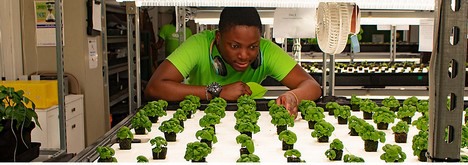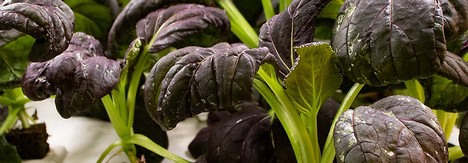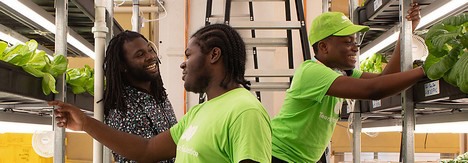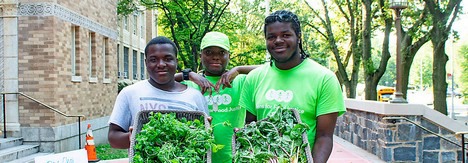Drive through the littered streets of the Bronx, New York City’s poorest borough. You’ll pass children playing in the water spray from a fire hydrant and empty storefronts covered in graffiti. Folks are perched on their stoops, hoping to catch a bit of breeze on a hot summer day. The last thing that comes to mind is farming. The second to last may be vegetables: block after block of bright neon signs announce the presence of yet another meat- and carbohydrate-heavy fast-food joint—a typical urban food desert.
The Bronx is home to DeWitt Clinton High School, incongruously housed in a majestic 1920s building complete with Tiffany chandeliers and a roster of famous alumni including James Baldwin, Neil Simon, Stan Lee, and Ralph Lauren. The school’s glory days are long past, however. Last year, DeWitt Clinton ranked fourth-highest among all New York City schools in the number of gun seizures, and it graduated significantly fewer students who went on to college than the average city high school.
But way up on the third floor, at the end of a long hallway, sits a classroom unlike any other at the school. Flooded with light and filled with shelf after shelf of leafy vegetables, it is the source of all the vegetables served in the nearly 3,000-student school’s cafeteria—and of both inspiration and aspiration for the student-farmers who care for it.

Green teens
Those vegetables—everything from bok choy to wasabi arugula —are growing hydroponically, as part of a program called Teens for Food Justice (TFFJ). The students grow enough lettuces, leafy greens, and herbs—an extraordinary 19,000 pounds a year—not just to supply the cafeteria but to sell at their community market at reasonable prices. This is no small feat in a neighborhood where approximately 46 percent of children live below the poverty line, 33 percent of the population is obese, and access to fresh vegetables is limited.

TFFJ is an independent nonprofit that organizes programs like the one at DeWitt Clinton in a growing number of food-insecure communities. Since 2013, when the organization built its first hydroponic farm in the low-income neighborhood of Bedford-Stuyvesant, Brooklyn, the focus has been on training youth in hydroponic urban agricultural farming in order to give their communities access to sustainable, healthy food. In the process, the students learn about entrepreneurship, health and nutrition, community advocacy, and the science and technology skills they’ll need in a new green-sector economy. There are currently two other established programs in Brooklyn, and three more sites in New York City are planned for in the next year. The organization is also developing three sites in Miami in partnership with the Gloria Estefan Foundation. TFFJ is just one of countless such programs all over the country that teach young people what it means to grow your own food.
About 100 students from DeWitt Clinton participate in TFFJ every year. While the majority are involved through school curriculum classes (environmental sustainability or advanced placement environmental science), a handful participate in an after-school program that has an additional focus on social entrepreneurship, food justice and advocacy, and relieving the problems of food insecurity. All the students build and maintain a high-tech hydroponic farm, where they learn about the biology of plants, use chemistry, math, and data tracking to maintain plant health, and learn basic plant and human nutrition.
Best of all, the students are learning about urban farming in a tangible, real-life, hands-on context, in which they advocate for their communities and acquire the tools they need to create an oasis in their food desert and build a healthier future.
Student advocates
As Joshua Delgado, who graduated from DeWitt Clinton in June, shows visitors around the farm, he speaks with pride about both the growing process and the vegetables. He walks around the racks of shelves, pointing as he explains how the plants are transplanted. His favorite job, he says with a broad smile on his face, is “to clean the systems—I’d make sure they were sparkling clean.”

The students are learning the bigger-picture benefits of urban farming. “Food justice is about the ability to get that healthy food and how it’s not really that easy to get it because there’s a lot of fast-food places around,” says Joshua. In fact, in this neighborhood there are 114 square feet of supermarket per 100 people—as compared to 450 square feet per 100 people in one wealthier Staten Island neighborhood, for example.
Learning about the health impacts of eating more vegetables is an important part of TFFJ. At the program’s Fresh Food Box market, where the produce not used by the cafeteria is offered for sale, several students stand behind tables laden with baskets of greens, herbs, peppers, and other produce with a cashbox at the ready. Tenth-grader Miguel Graham is demonstrating how to cook a stir-fry of yellow and green peppers with sausage. As Miguel flips the food around in the sizzling pan, he talks about how the program has taught him how vegetables “can help you live longer.” Before, he says, “I wasn’t really interested in vegetables, but since I’ve been in this program, I started loving vegetables more.”

TFFJ intern Jholie Meikle, who graduated from DeWitt Clinton this past June, is walking a potential customer through the various greens. Jholie says that the program has taught her that staying healthy doesn’t have to be expensive, and it has changed the way she shops. “Now when I go, I look at the nutrition facts.” Jholie also credits the program for exposing her three-year-old daughter to new fresh foods. “She comes with me a lot,” says Jholie. “One day she saw Swiss chard and she just started eating it. Now, every time she sees it, she has to have it.”
Learning experiences
As the students learn the science of hydroponic farming, they are also learning how to reduce their environmental impact. Hydroponics requires just a quart of water per head of lettuce, while traditional agriculture methods use more than 4 gallons. The students use no herbicides, pesticides, or fungicides. And by growing right where the produce is being consumed, they avoid the cost in both dollars and carbon emissions of transportation.
“The kids are really motivated by the environmental impact of the farm and are aware of current environmental issues,” says Clare Hyre, TFFJ’s senior program manager. An added benefit: “The food I grow tastes better than the food other people grow,” Miguel states emphatically.
But TFFJ was not conceived as simply a place to grow food. Students gain a hands-on, relatable STEM education as they learn how to build and maintain a high-tech hydroponic farm, which requires engineering, architectural drafting, and mathematics. They learn about the biology of plants and use chemistry and data tracking (math again!) to maintain plant health. They also learn basic plant and human nutrition, explore the nutrient content of what they grow, and apply their nutrition knowledge while tracking their own food consumption and exercise.
Social entrepreneurship is also an important part of the program. The students write a business plan to run their own farm stand. They learn to address the details required to run a successful business, including targeting an audience, distribution, and analyzing the competition.
As the teens become excited about the program and advocate for it to others, they are building self-confidence, and communication and public speaking skills. After their first round of apprenticeship in the program, they can come back and train, or mentor, other students, which helps develop their ability to lead. After they graduate from the program, they can earn a stipend as they help run the Fresh Food Box program, mentor students, and continue to develop their leadership abilities.
Growing their food—and their world
In a resource-deprived neighborhood where canned and fast foods dominate, learning to farm helps these young people break away from the confines of their environment. Farming gives them access to healthier foods, amps up their STEM education, and makes them better leaders, stewards of their environment, and advocates for their community. And sometimes it makes them want to be farmers. Joshua dreams of having enough money to build his own hydroponic farm. He has researched it online, he says, and he thinks he could do it.
When he does, he will be part of the solution for sustainable farming that brings healthy food to communities in need—just like the organization that taught and inspired him.
For more information: Corteva Agriscience
Corteva Agriscience
www.corteva.com
